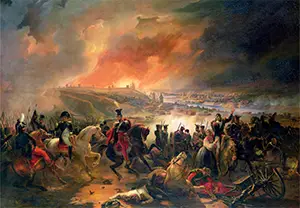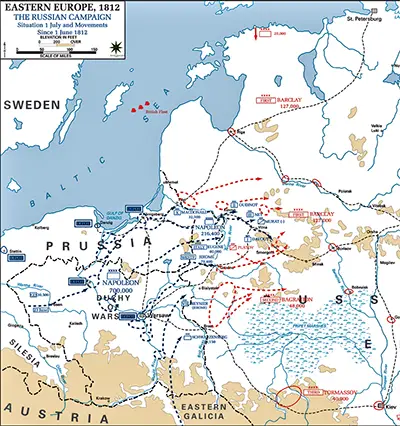The French Invasion of Russia in 1812
Part 3: Invasion and Evasion
The plan was to confront the Russian armies, achieve a great victory, and convince Alexander to sue for peace and return to the kind of arrangement that the two leaders had crafted at Tilsit in 1807. Time and again, however, the Russians did not do what was expected. On June 23, the Grand Armée crossed over the Niemen River and into Russia. Even by this point, a month into the expedition, they were starting to run short on supplies, even though the supply network was extensive and well provisioned, stretching all along the corridor of travel. Four days later, they captured the city of Vilna and found that nothing much remained of value in the city. The Russian army had slipped away, leaving little to conquer. That night, the invaders suffered through an unseasonable storm of hail and sleet. Such weather muddied whatever sparse roads existed in that part of the country, forcing draft animals and transport wagons to proceed even more slowly than normal. Blazing summer heat followed unseasonal storms, hardening ruts created by heavy wagons and stalling the progress of those wagons and the soldiers who needed what was in those wagons. As a result, infantry traveled much more quickly than the artillery that they hoped to use in battle and the supplies that they needed to fight those battles and to survive afterward. The vaunted Napoleonic strategies of lightning fast marches and turn-on-a-dime pivots to confront and surprise a new enemy that had worked so well in previous wars could not be employed in the wastelands of western Russia. It was all well and good that Warsaw contained a very large arsenal of guns, gunpowder, and cannons; it was little good to an army whose method of transport depended on simple things like dry dirt on which a wagon's wheels could safely operate. Such wagons went much more quickly on the paved roads of Western and Central Europe. Even worse for the French, a sudden storm had resulted in the deaths or otherwise loss of 10,000 horses. French forces did have a brief window of opportunity when the Russian southern army under Bagration was in and around Vilna not long before French troops arrived there, but a series of missteps including a serious error in pursuit by Jerome Bonaparte (Napoleon's brother) and a false reconnaissance report that convinced a large French contingent to stand pat for an entire day waiting to engage what turned out to be a phantom Russian division resulted in the Russian army's eluding their pursuers and setting off further to the south. Jerome Bonaparte resigned as a result, but the damage had been done. One thing that the French forces did succeed at doing was convincing Barclay de Tolly to abandon the extensive fortifications that had been laboriously constructed at Drissa, removing from French battle plans a series of assaults that would have cost a great many lives. A similar misadventure occurred a few weeks later, as the French army had finally caught up with Barclay de Tolly and his men and had fought at Ostronovo for two days, July 25–26. Napoleon, rather than attacking anew, chose to wait for his own reinforcements to arrive; while he waited, the Russian force melted away. 
As the invasion force pressed on in search of a military victory, the defenders kept on retreating, abandoning Vitebsk and then, significantly, Smolensk, burning buildings, munitions stores, and (perhaps most importantly to the French at this point) crops as they fled. At the very edge of French-controlled territory were abundant stores of food, water, and medical supplies; none of that could be transported to an army that was being pulled away to the east more quickly than anticipated. It was the middle of summer at this point, and problems with water supply for the Grand Armée resulted in soldiers' drinking unsafe water and getting dysentery. Many also succumbed to typhoid fever, borne by insects living in swamps. Others had struggled in the summer heat to carry their excess food and had discarded it. Still others deserted; as the campaign wore on, those numbers skyrocketed. As well, deserters sought comforts in the possession of whatever little local population remained in the wake of the passage of the large armies, creating havoc that interfered with French lines of supply. The French force had taken some time at Vitebsk, to rest and await the arrival of supplies and reinforcements. The preference of the emperor and all of his commanders was to spend the rest of the year there and continue the invasion in the spring. At his most optimistic, Bonaparte had, if the war was still on, planned to be as far east as Smolensk before stopping the campaign for the winter, thinking to spend the cold months behind the lines. Now that they had advanced so far, he decided to go farther, overriding the will of his commanders and succeeding in convincing them to continue the fight. One of the main factors in doing this was the knowledge that delaying the invasion by a handful of months would give both sides the opportunity to add reinforcements. Bonaparte knew that his ability to do this would be more difficult than Russia's, and he also knew that such a sustained absence from Paris might encourage an insurrection, especially because the guerrilla wars in Spain showed no signs of easing. Next page > Fighting and Dying > Page 1, 2, 3, 4, 5 |
|
Social Studies for Kids
copyright 2002–2024
David White



 At the time, the Russian army was split into two main forces, one on either side of the Pripet Marshes. To the south was Pyotr Bagration, and to the north was Michael Andreas Barclay de Tolly; combined, their forces numbered fewer than 500,000. To the north were Moscow and possibly St. Petersburg; to the north was also colder climates. To the south were Kiev and warmer climates; attacking to the south would also mean a longer route to Moscow. Bonaparte decided to attack north of the Pripet Marshes and aim to prevent the two Russian forces from meeting up.
At the time, the Russian army was split into two main forces, one on either side of the Pripet Marshes. To the south was Pyotr Bagration, and to the north was Michael Andreas Barclay de Tolly; combined, their forces numbered fewer than 500,000. To the north were Moscow and possibly St. Petersburg; to the north was also colder climates. To the south were Kiev and warmer climates; attacking to the south would also mean a longer route to Moscow. Bonaparte decided to attack north of the Pripet Marshes and aim to prevent the two Russian forces from meeting up.
